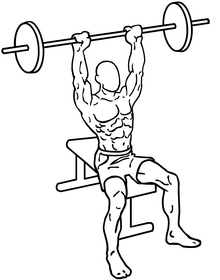Overhead press

The overhead press, also known as the shoulder press, strict press or military press, is an upper-body weight training exercise in which the trainee presses a weight overhead while seated or standing. It is mainly used to develop the anterior deltoid muscles of the shoulder.[1] The standing version was once a component of the sport of Olympic weightlifting as part of the clean and press movement, but was removed in 1972 due to difficulties in judging proper technique.[2]
The lift is set up by taking either a barbell, a pair of dumbbells or kettlebells, and holding them at shoulder level. The weight is then pressed overhead.[3] While the exercise can be performed standing or seated, standing recruits more muscles as more balancing is required in order to support the lift.[4] Other variations of the exercise include the push press, a similar movement that involves an additional dipping motion in the legs to increase momentum.[1] An overhead press may also be performed unilaterally, with the lift being performed one handed; or in an alternating fashion with both hands holding a dumbbell or kettlebell, and then pressing with one arm and then the other.[5]
See also
References
- ^ a b Boly, Jake (16 March 2021). "The Overhead Press May Just Be the Best Pressing Movement Around". BarBend. Retrieved 2022-03-25.
- ^ Fair, John D. (2001). "The Tragic History of the Military Press in Olympic and World Championship Competition, 1928-1972". Journal of Sport History. 28 (3): 345–374. ISSN 0094-1700.
- ^ "How To Overhead Press: A Beginner's Guide". Bodybuilding.com. 2015-08-12. Retrieved 2018-09-11.
- ^ "The Overhead Press: The Difference Between Seated, Standing, Dumbbell and Barbell". Breaking Muscle. 17 March 2022.
- ^ Boyle, Michael (2016). New Functional Training for Sports. Champaign: Human Kinetics. p. 168. ISBN 978-1-4925-3061-9.
Further reading
- Rippetoe, Mark; Kilgore, Lon (2007). Starting Strength: Basic Barbell Training. ISBN 978-0-9768054-2-7.
- Kapandji, Ibrahim Adalbert (2007). The Physiology of the Joints: The upper limb. ISBN 978-0-443-10350-6.
